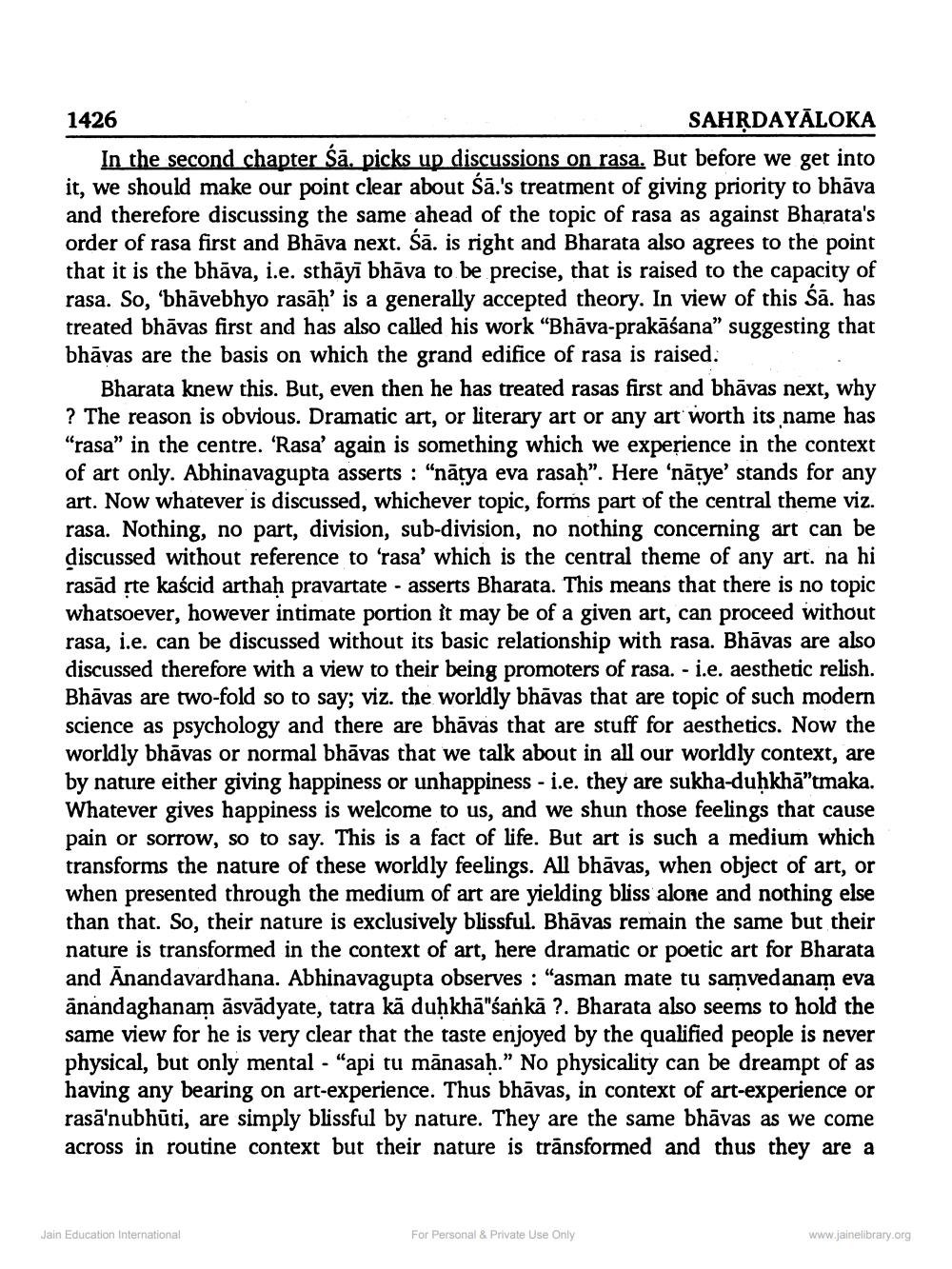________________
1426
SAHṚDAYALOKA
In the second chapter Śā. picks up discussions on rasa. But before we get into it, we should make our point clear about Śa.'s treatment of giving priority to bhāva and therefore discussing the same ahead of the topic of rasa as against Bharata's order of rasa first and Bhāva next. Śā. is right and Bharata also agrees to the point that it is the bhāva, i.e. sthāyī bhāva to be precise, that is raised to the capacity of rasa. So, 'bhāvebhyo rasaḥ' is a generally accepted theory. In view of this Śā. has treated bhāvas first and has also called his work "Bhāva-prakāśana" suggesting that bhāvas are the basis on which the grand edifice of rasa is raised.
Bharata knew this. But, even then he has treated rasas first and bhāvas next, why ? The reason is obvious. Dramatic art, or literary art or any art worth its name has "rasa" in the centre. 'Rasa' again is something which we experience in the context of art only. Abhinavagupta asserts: "natya eva rasaḥ". Here 'nātye' stands for any art. Now whatever is discussed, whichever topic, forms part of the central theme viz. rasa. Nothing, no part, division, sub-division, no nothing concerning art can be discussed without reference to 'rasa' which is the central theme of any art. na hi rasad ṛte kaścid arthaḥ pravartate - asserts Bharata. This means that there is no topic whatsoever, however intimate portion it may be of a given art, can proceed without rasa, i.e. can be discussed without its basic relationship with rasa. Bhāvas are also discussed therefore with a view to their being promoters of rasa. - i.e. aesthetic relish. Bhāvas are two-fold so to say; viz. the worldly bhāvas that are topic of such modern science as psychology and there are bhāvas that are stuff for aesthetics. Now the worldly bhāvas or normal bhāvas that we talk about in all our worldly context, are by nature either giving happiness or unhappiness - i.e. they are sukha-duḥkhā❞tmaka. Whatever gives happiness is welcome to us, and we shun those feelings that cause pain or sorrow, so to say. This is a fact of life. But art is such a medium which transforms the nature of these worldly feelings. All bhāvas, when object of art, or when presented through the medium of art are yielding bliss alone and nothing else than that. So, their nature is exclusively blissful. Bhāvas remain the same but their nature is transformed in the context of art, here dramatic or poetic art for Bharata and Anandavardhana. Abhinavagupta observes: "asman mate tu samvedanam eva anandaghanam āsvādyate, tatra kā duḥkhā"śankā ?. Bharata also seems to hold the same view for he is very clear that the taste enjoyed by the qualified people is never physical, but only mental - "api tu mānasaḥ." No physicality can be dreampt of as having any bearing on art-experience. Thus bhāvas, in context of art-experience or rasa'nubhūti, are simply blissful by nature. They are the same bhāvas as we come across in routine context but their nature is transformed and thus they are a
Jain Education International
For Personal & Private Use Only
www.jainelibrary.org




